Opinion: What’s left of Russia’s Black Sea Fleet?
Russia’s war against Ukraine is shattering the conventions of warfare in many ways. One of the most illustrative examples is the systematic destruction of Russia’s Black Sea Fleet (BSF) by Ukraine, a country that has virtually no navy of its own. The Ukrainian military’s use of coastal missile systems, air-launched cruise missiles, and sea and air drones has forced Russia to up its Black Sea port defenses and create a naval base in Russian-occupied Abkhazia.
An early symbol of humiliation was the destruction of the Russian cruiser Moskva, the BSF’s flagship, by Ukrainian Neptune missiles in mid-April 2022. This marked the second time in history that a cruiser-class ship was destroyed in combat since the Argentine ARA General Belgrano was sunk by a British submarine during the Falklands War in 1982.
The Moskva was the only ship in the BSF equipped with anti-aircraft missile systems, meaning it was capable (at least theoretically) of defending not only itself but also an entire naval formation from an air attack. After the Moskva was destroyed, the BSF could no longer operate freely in the northwestern part of the Black Sea, and plans for a naval landing near Odesa were finally put to rest.
Read also: Opinion: Ukraine may have no choice but to lower its fighting age
Russia’s Black Sea Fleet
The BSF’s development was not a priority during the Soviet Union and in the aftermath of its collapse. The fleet degraded amid the long process of dividing it between Russia and Ukraine (this lasted until 1997 and resulted in Russia retaining the majority) and the economic crisis that persisted into the 2010s.
The BSF had no strategic perspective, and limited resources were instead primarily allocated to Russia’s Northern and Pacific fleets. Russia’s leadership was, however, aware of the BSF’s political significance, as its existence allowed Russia to maintain a base in Sevastopol in now-occupied Crimea.
The BSF’s importance in realizing Russian President Vladimir Putin’s imperialist ambitions became apparent in 2008. After Russia launched its war against Georgia, Russian navy vessels conducted naval blockades, intercepted Georgian maritime traffic, ensured the transfer of troops, and provided naval fire support for Russian ground forces.
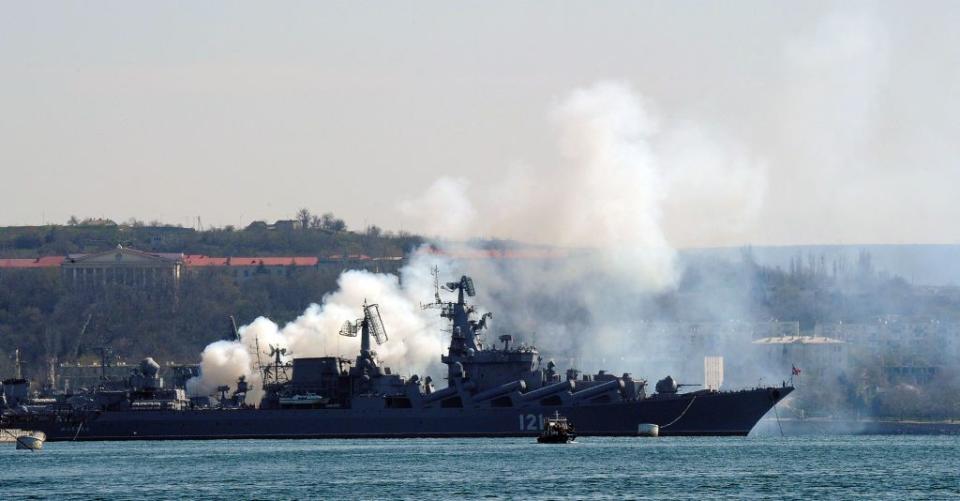
As a result, Russia initiated two major BSF renewal programs in 2010: the purchase of six Improved Kilo II (Project 636.3) submarines and six Admiral Grigorovich-class (Project 11356R) frigates. Both the submarines and the frigates were improved versions of Soviet-era designs. The six submarines arrived in Sevastopol after Russia annexed Crimea in 2014. Because the Black Sea enterprises capable of building warships remained in Ukraine after the collapse of the Soviet Union, Russia produced them in the Baltic Sea.
The situation with the frigates was more complicated because Russia didn’t produce its own gas turbines – they were manufactured in Mykolaiv. By the time Ukraine imposed an embargo on their supply after Russia annexed Crimea, Russia had only received three of the engines required for the six frigates. The BSF thus only received three frigates in 2016-2017: Admiral Grigorovich, Admiral Essen, and Admiral Makarov.
The issue with turbine production is quite serious for Russia. For example, when the Russian frigate Ladny’s gas turbines reached the end of their service life in 2016, Russia had to install turbines from the decommissioned Russian cruiser Kerch because of sanctions.


Six Project 22160 patrol ships were also commissioned for the BSF. The ships resembled Western Offshore Patrol Vessels (OPV) in that they were lightly armed and designed primarily for police missions – a contrast to the Soviet concept that had even the smallest ships maximally equipped with various weapons.
Four of the ships were built in Zelenodolsk and two were built in the city of Kerch in Russian-occupied Crimea. The first three ships came into service between 2018 and 2020, and the fourth in July 2022 after the start of Russia’s full-scale war against Ukraine. The two ships built in Kerch have yet to come into service.
The BSF received four Buyan-class (Project 21631) corvettes, small artillery and missile ships, built in Zelenodolsk between 2018 and 2021 after sanctions-induced delays. While they were meant to be equipped with German-made diesel engines, the onset of sanctions ended the cooperation and so the corvettes were equipped with Chinese dupes.
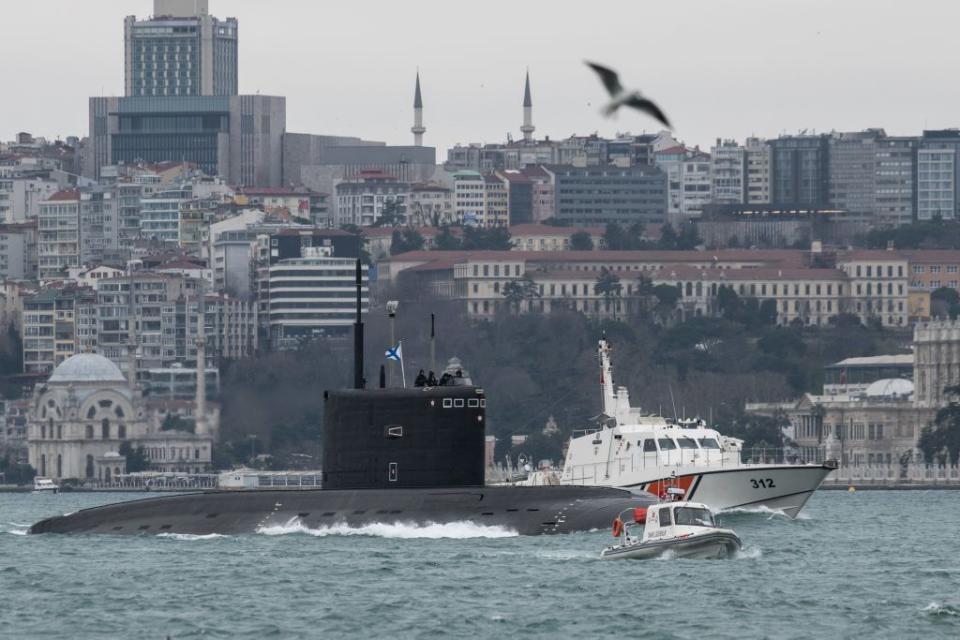
Karakurt-class (Project 22800) corvettes, similar in size to the Buyan-class corvettes but with slightly better seaworthiness, were meant to compensate for the outstanding Admiral Grigorovich-class frigates. However, because their delivery is significantly behind schedule, only one of the eight Karakurt-class corvettes has been commissioned so far – Cyclone in July 2023.
Russia also deployed six large amphibious assault ships from its Baltic and Northern fleets to the Black Sea in early February 2022 in preparation for its full-scale war against Ukraine. These ships were an addition to the six pre-existing ships of this class in the BSF.
The blocking of the Black Sea amid the full-scale war has affected the BSF’s potential. Some of the fleet’s ships, including the frigate Admiral Grigorovich , Improved Kilo II submarines, a minesweeper, and several small boats, based outside of the Black Sea as of Feb. 24, 2022, have been unable to return. The new Steregushchiy-class (Project 20380) corvette Mercury, built in St. Petersburg and formally assigned to the BSF in May 2023, has also been unable to reach its destination.
Russia’s war against Ukraine
In Russia’s war against Ukraine, the BSF has several key objectives.
The first is to strike civilian and military infrastructure with Kalibr cruise missiles. Improved Kilo II submarines, the frigates Admiral Makarov and Admiral Essen, and Buyan- and Karakurt-class corvettes are used to do this. The submarines can carry four Kalibr missiles, which they launch through torpedo tubes. The surface ships have vertical launchers for eight Kalibr missiles.
The BSF’s second objective is to transport Russian weapons and military equipment, which is conducted using large landing ships.
The third objective is to control maritime communications and attempt to disrupt Ukraine’s exports in the Black Sea. This involves Project 22160 patrol ships, older corvettes and missile boats, and auxiliary ships.
Losses
The losses sustained by Russia’s BSF must be approached with caution, as it is often difficult to confirm both the extent of the damage and which ships were hit. For example, Ukrainian forces reported having hit the patrol ship Vasyl Bykov near Odesa on March 7, 2022, but the Buyan-class corvette Velikiy Ustyug was likely the ship damaged. It’s also difficult to determine the extent of the damage sustained by the frigate Admiral Essen which was hit by an anti-ship Harpoon missile on April 4, 2022.
Some losses sustained by the BSF have been unequivocally confirmed, however. Ukrainian forces destroyed the landing ship Saratov near the port city of Berdiansk in occupied Zaporizhzhia Oblast with a Tochka-U ballistic missile in March 2022. Two other landing ships were also likely hit. This marked the first time in the history of naval warfare that a ship was destroyed by a ballistic missile.
Read also: Opinion: How many planes does Russia have?
One of the most high-profile losses was the destruction of the cruiser Moskva in April 2022. The Kremlin tried to downplay the loss, claiming it “lost its stability due to damage to the hull received during the fire from the detonation of ammunition… during the towing of the Moskva cruiser to the port of destination.”
At least two patrol ships were damaged by Ukrainian Bayraktar drones in May-June 2022 amid the fight for Ukraine’s Snake Island in the Black Sea. Landing ships and other larger vessels used to supply Russian forces on the island may also have been destroyed by Ukrainian anti-ship missiles.
Ukraine claimed to have severely damaged the logistics ship Vsevolod Bobrov near Snake Island with Neptune missiles in May 2022. In June 2022, Ukraine sunk the tug Vasily Bekh with two Harpoon missiles, preventing it from delivering supplies to the island.
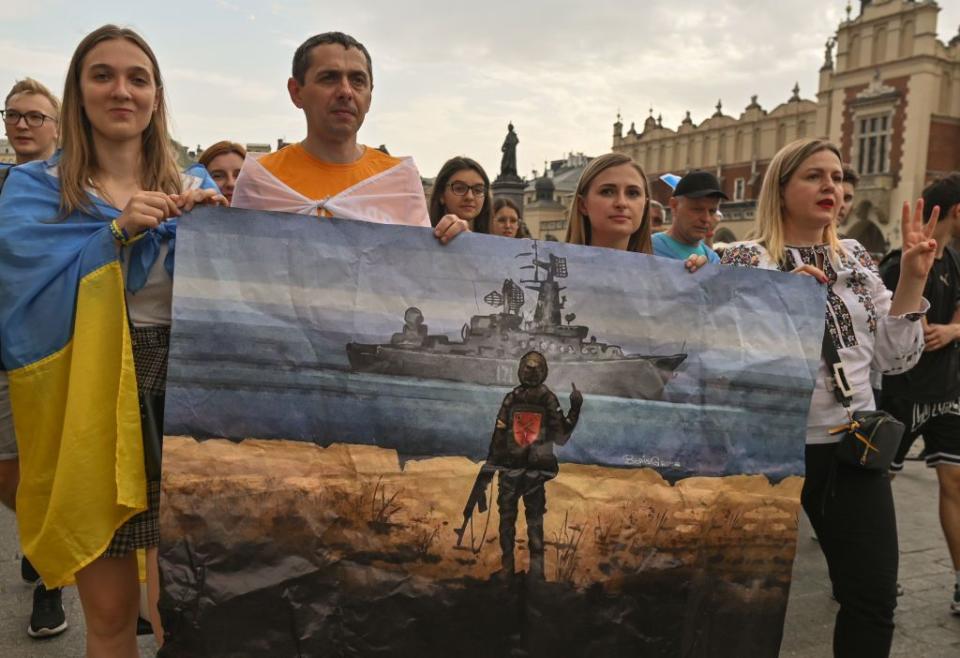
Ukrainian forces started to employ new means in the fall of 2022, namely unmanned sea drones. Sea drones were used to damage the frigate Admiral Makarov, the minesweeper Ivan Golubets, and another vessel in October 2022 in occupied Sevastopol in Crimea.
The reconnaissance ship Ivan Khurs, designed to provide communications and fleet control, was damaged 140 kilometers northeast of the Bosphorus Strait in May 2023.
The landing vessel Olenegorskiy Gornyak was damaged in August 2023 by a sea drone operation conducted by the Security Service of Ukraine (SBU) and the Ukrainian Navy. Stationed in Novorossiyk Bay, it was the largest Russian ship to be damaged after the Moskva. According to the U.K. Defense Ministry, the ship often ferried military and civilian traffic between Russia and occupied Crimea when traffic on the Kerch Bridge was disrupted due to attacks.

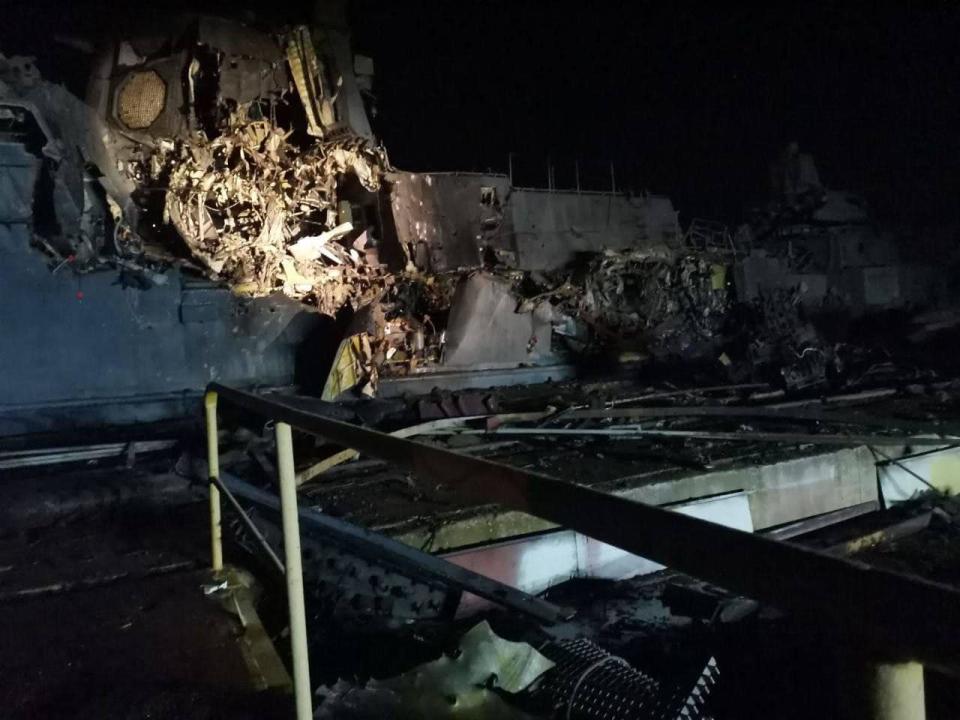
Ukraine carried out a series of attacks against the BSF on Sept. 14, 2023. The landing vessel Minsk was “functionally destroyed” after a Ukrainian missile attack on a shipyard in Sevastopol. The Improved Kilo II submarine Rostov-on-Don also sustained “catastrophic damage.” The Ukrainian military claimed the attack on the shipyard killed 34 Russian officers and injured 105. A Ukrainian drone attack the next day hit the patrol boat Sergey Kotov and a corvette Samum.
A very important event took place on Nov. 4, 2023: The Karakurt-class corvette Askold, which could carry up to eight Kalibr missiles, was damaged, potentially beyond repair, by Ukrainian cruise missiles at a shipyard in Kerch in occupied Crimea. The ship was reportedly being tested and had yet to be accepted into the BSF.
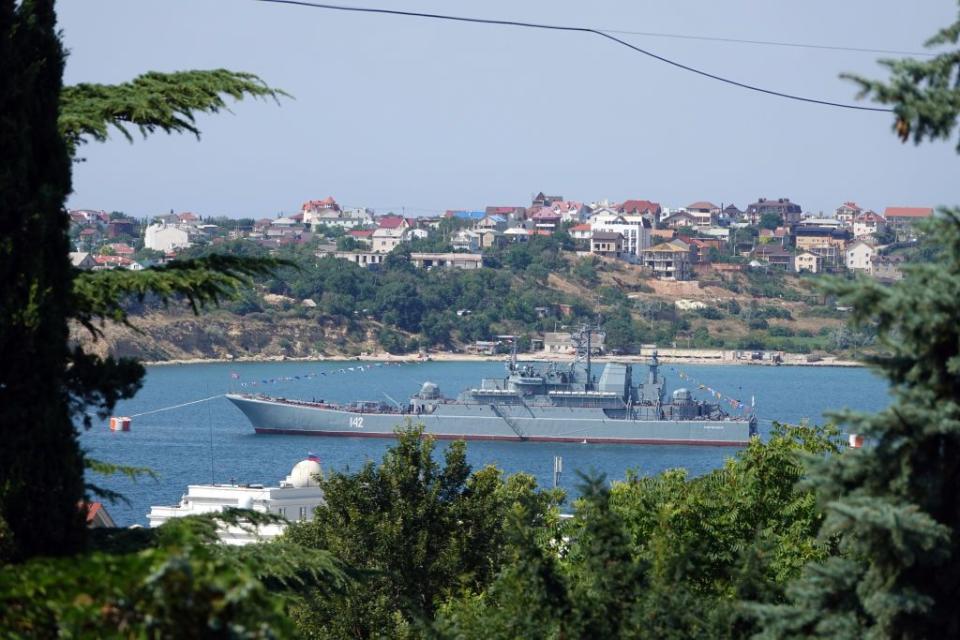
In December 2023, the landing ship Novocherkassk was “completely destroyed” by Ukrainian cruise missiles. Docked in Feodosia in occupied Crimea, the ship was reportedly carrying military cargo and explosives. The Novocherkassk, a mid-sized vessel designed for amphibious landings, could carry 240 people.
The constant threat of Ukrainian missile and drone attacks on the BSF forced Russia to withdraw its main warships from Sevastopol to Novorossiysk and even begin resuscitating its old Soviet base in Russian-occupied Abkhazia. Russia’s focus shifted from maintaining its Black Sea blockade to guarding its own bases.
Ukraine sunk the corvette Ivanovets off the coast of Crimea overnight on Jan. 31, 2024, after it sustained “direct hits to its hull” by sea drones. The Ivanovets was reportedly involved in live-fire exercises in the Black Sea in July 2023 after Russia withdrew from the Black Sea Grain Initiative and subsequently declared that all vessels sailing to Ukrainian ports would be considered military targets.
Read also: Opinion: How many tanks does Russia have left?
A joint operation between Ukraine’s military intelligence and armed forces used sea drones to sink the landing ship Caesar Kunikov near Alupka in occupied Crimea on Feb. 14, 2024. The patrol ship Sergey Kotov, which was first hit in September 2023, suffered the same fate at the hands of Ukrainian sea drones near the Kerch Strait on March 5. Ukraine’s military intelligence said Russia intended to equip the ship with anti-aircraft missile systems and had a helicopter on board.
On March 24, 2024, Ukrainian missiles hit the landing ships Yamal and Azov, as well as the reconnaissance ship Ivan Khurs, which was previously damaged in May 2023. According to the Ukrainian military, Yamal and Azov had 98 and 87 crew members, respectively.
Two days later, Ukrainian forces used Neptune missiles to destroy the landing ship Konstantin Olshansky. While the Konstantin Olshansky was not part of the BSF, the Ukrainian Navy’s spokesperson, Dmytro Pletenchuk, said it was being “prepared for use against Ukraine.”
What’s left of the Black Sea Fleet?
The Ukrainian Navy claimed in March to have destroyed one-third of the fleet since the start of the full-scale war. So what’s left of Russia’s Black Sea Fleet?
First, the BSF’s Kalibr missile-capable vessels remain virtually undamaged. Three of the four submarines, the two Admiral Grigorovich-class frigates, and four corvettes capable of carrying these missiles remain in service. Russia is even replenishing the stock of its corvettes despite the Black Sea being blocked, bringing ships through inland waterways.
However, due to the constant threat posed by Ukrainian missile and drone attacks, these carriers’ operations are severely limited. During the mass missile attacks against Ukraine in March of this year, Russia didn’t use Kalibr cruise missiles – only air- and ground-launched missiles.
Meanwhile, the BSF’s amphibious forces have been seriously impacted. Three amphibious ships have been destroyed and four damaged (and the Minsk is likely beyond repair). This significantly limits Russia’s ability to conduct amphibious operations and transport personnel and equipment by sea.
Russia’s patrol forces have three modern patrol ships, two old frigates, around 10 minesweepers, various auxiliary vessels, some small boats, and several corvettes and missile boats inherited from the Soviet Union. They have proven incapable of blocking Ukraine’s maritime communications.
Ukraine has neutralized the BSF quite effectively, utilizing tactics reminiscent of the Jeune École, a French naval concept developed in the 19th century that advocated the use of small, heavily armed vessels to combat larger battleships.
However, it’s important to note that the maritime theater is far from being front and center in this war. This war will not be won at sea, so Ukraine’s key focus now should be to obtain modern fighter aircraft and strengthen its air defense and artillery.
Editor’s Note: The opinions expressed in the op-ed section are those of the authors and do not purport to reflect the views of the Kyiv Independent.
We’ve been working hard to bring you independent, locally-sourced news from Ukraine. Consider supporting the Kyiv Independent.

